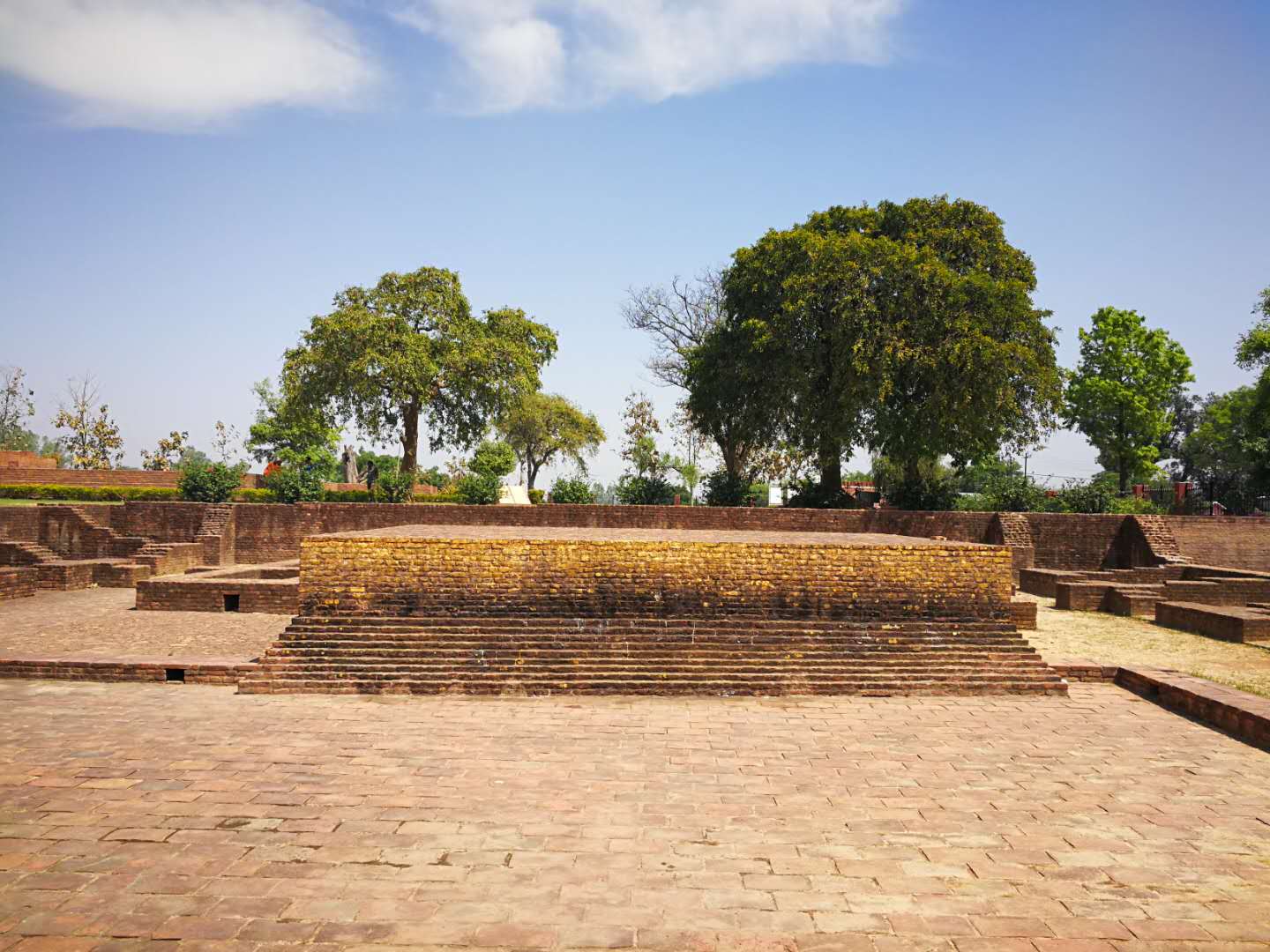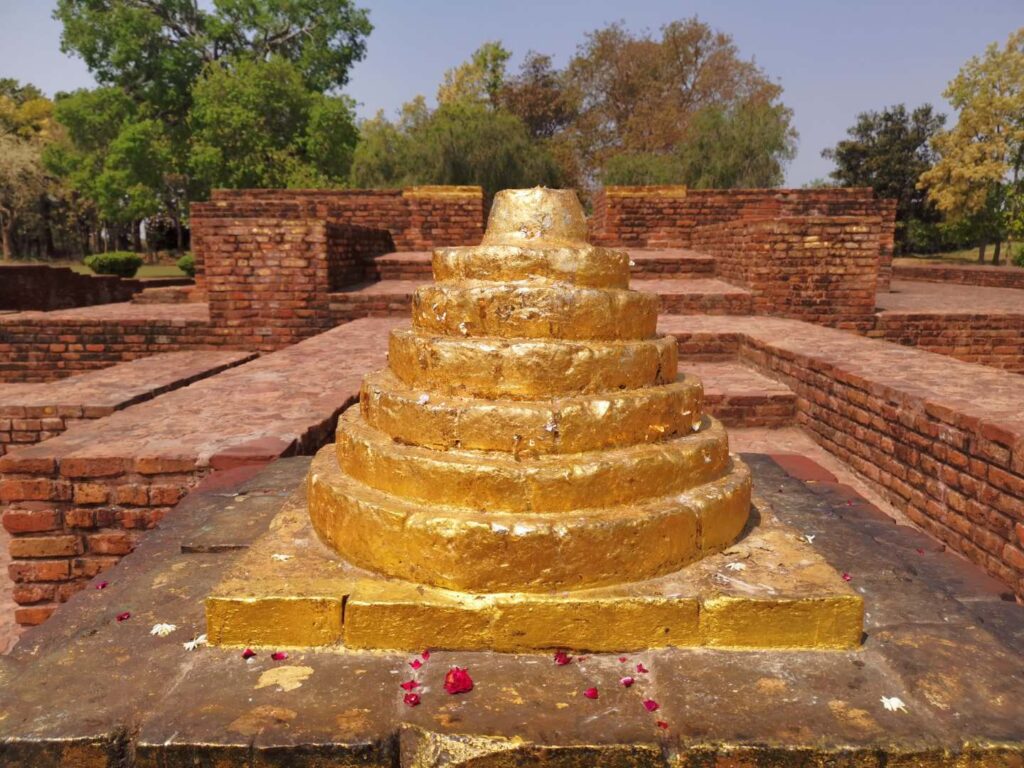Jetavana
Jetavana was one of the most famous of the Buddhist monasteries or viharas in India (present-day Uttar Pradesh). It was the second vihara donated to Gautama Buddha after the Venuvana in Rajgir.
Jetavana was the place where the Buddha gave the majority of his teachings and discourses, having stayed at Jetavana nineteen out of 45 vassas, more than in any other monastery.It is said that after the Migāramātupāsāda, a second vihara erected at Pubbarama close to Savatthi was built by the Buddha’s chief female lay disciple, Visakha, the Buddha would dwell alternately between Jetavana and Migāramātupāsāda, often spending the day in one and the night in the other.

Donation of Jetavana. Anathapindika covers Jetavana with coins (Bharhut). Following Anathapindika’s first encounter with the Buddha, he requested to offer him a meal, which the Buddha accepted, and then asked to build a temple for him and his monks in his hometown of Savatthi, to which the Buddha agreed.
Shortly after, Anathapindika went back to Savatthi to search for a place to build the monastery. Looking for a place that was both accessible to followers and peacefully secluded, he came across a park belonging to Prince Jeta, the son of King Pasenadi of Kosala. Anathapindika offered to buy the park from the prince but the prince refused, after Anathapindika persisted, the prince joking said he will sell him the park if he covers it with gold coins, to which Anathapindika agreed.

Anathapindika later came back with wagons full of gold pieces to cover the park with. When Prince Jeta stated that he was merely joking and still would not sell the park, Anathapindika and the prince went to arbitrators who concluded that Prince Jeta had to sell the park at the mentioned price.
The money brought in the first journey was found insufficient to cover one small spot near the gateway. So Anāthapindika sent his servants back for more, but Jeta, inspired by Anāthapindika’s earnestness, asked to be allowed to give this spot. Anāthapindika agreed and Jeta erected there a gateway, with a room over it. Anāthapindika built in the grounds dwelling rooms, retiring rooms, store rooms and service halls, halls with fireplaces, closets, cloisters, halls for exercise, wells, bathrooms, ponds, open and roofed sheds, etc.
It is said that Anāthapindika paid eighteen crores for the purchase of the site, all of which Jeta spent in the construction of the gateway gifted by him. Jeta gave, besides, many valuable trees for timber. Anāthapindika himself spent fifty-four crores in connection with the purchase of the park and the buildings erected in it.
The ceremony of dedication was one of great splendour. Not only Anāthapindika himself, but his whole family took part: his son with five hundred other youths, his wife with five hundred other noble women, and his daughters Mahā Subhaddā and Cūla Subhaddā with five hundred other maidens. Anāthapindika was attended by five hundred bankers. The festivities in connection with the dedication lasted for nine months.

The following is from Nancy’s sharing:
Hi everyone, welcome to my channel, Rising of Bodhisattvas. This is Nancy from the International Buddha Dharma Society for Cosmic Law in America. It’s a great honor to be here sharing the Pilgrimage trip with you. How are you doing? Today is Dec. 12th, 2020. This would be our last Pilgrimage trip video. And today, we will visit the most famous Jetavana Vihara in Sravasti, the ancient capital city of Kosala. And then we will go to the National Museum of India to visit the Buddha’s relics.
Jetavana Vihara has different translated names. It is located outside of the old city of Sravasti. It was offered to the Buddha by his famous lay disciple Anathapindika. There is a story behind it. It’s said that after Anathapindika encountered the Buddha, he asked the Buddha to allow him to build a Vihara for him and his disciples, which the Buddha agreed. After Anathapindika returned to Sravasti, he began to look for a place for this vihara. He came across a park which was owned by Prince Jeta, the son of King of Kosala. He wanted to buy this park, but Prince Jeta refused. He joked that if Anathapindika could cover the park ground with golden coins, then he would sell this park to him. Unexpectedly, Anathapindika agreed. He came back with wagons full of gold coins. Prince Jeta was moved by Anathapindika’s earnestness. At the end, he donated the forest in the park to the Buddha. So This Vihara is also called Jetavana Anathapindika Vihara. Now let’s go to visit this vihara.
The Buddha stayed in Jetavana for 25 raining seasons and gave the most teachings here, such as the Diamond Sutra, the Buddha Speaking of Amitabha Buddha, Shurangama Sutra, and so on.
The Vihara has 12 stupas, 72 lecture halls, 3600 rooms and 500 pavilions. The main sacred places in Jetavana Vihara are the Ananda Bodhi tree, the Buddha’s abode and the Buddha’s preaching platform.
It’s said that the Buddha only lived in Jetavana Vihara 3 months a year during the raining season. The disciples missed the Buddha, so they asked Ananda to ask the Buddha to plant a Bodhi tree in the Vihara. Ananda plead the Buddha accordingly. So a Bodhi tree seed was planted by the door of the Vihara and named after Ananda.
By the Bodhi tree, people would circumambulate the Bodhi tree and chant the name of the Buddha. After that, they would light incense and bow to the Bodhi tree to express their respect. Meditate or recite some sutras here also. The trip is close to the end. It’s also a good time to transfer the merit accumulated from this pilgrimage trip here.
The well in the Vihara is kept very well and it’s a memorable time to drink some water from this well.
Walk into the Buddha’s abode and meditation room. Though they are just ruins, you can still imagine what they looked like over 2500 years ago. The room is square and the wall is really thick.
.
The Buddha’s preaching platform is made of red brick. The audience would sit on the four sides. It’s such a sacred place. Don’t forget to take some pictures with the Buddha here. One day you may give Dharma talks just like the Buddha.
Thus I have heard. Once the Buddha was staying in the Jetavana Vihara, together a gathering of great disciples 1250 in all. Among them are Shariputra, Maudgalyayana, Anandaÿ
This is how many sutras given in Jetavana Vihara started.
Leaving Jetanava Vihara, we headed to New Delhi for the returning trip. In the next morning, before going to the airport, we visited the National Museum of India where the Buddha’s relics were in display. If you google relics on the internet, you would see some beautiful pictures with beautiful the so-called relics. Often, they are round and even in different colors. People just believe without any doubts. Cheating in Buddhism? No way. But, now, let’s go to the most authoritative National Museum of India, the most trustful source, to see what relics really look like.
The 22 pieces of the Buddha’s relics are kept in a golden stupa. These relics were excavated from an ancient stupa by Indian archeologists in 1972 about 22 km away from Lumbini. As stated in the sutra, seeing the relics is seeing the Buddha. The Buddha is still here. Feeling the energy around you when you are there. Circumambulate the stupa, chant the name of the Buddha, and meditate for a while.
I take refuge in the Buddha. I take refuge in the Dharma. I take refuge in the Sangha.
Amitabha! This video ends our Pilgrimage trip. I hope this series of videos have been useful for you. You can take a virtual pilgrimage trip any time by watching these videos. Learning from the Buddha starts from understanding the Buddha. We always recommend people who are interested in the Buddha and Buddhism to read the Biography of the Buddha, and then recite sutras given by the Buddha, uphold at least the five basic precepts laid down by the Buddha. Learning from the Buddha is not just to blindly donate money to any temples, or listen to lectures given by anyone. Anyone who is interested in the Buddha and Buddhism should go to the Buddha in person. The books are just there. The sutras are just by the hands. There should be no distance between you and the Buddha. Make sense?
Again thank you everyone for being with me. It’s the end of the year. Have a joyful and blessed holiday season! Merry Christmas and Happy New year to you! Thank you! I will see you next time! Bye.

